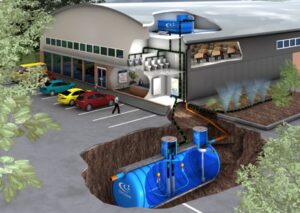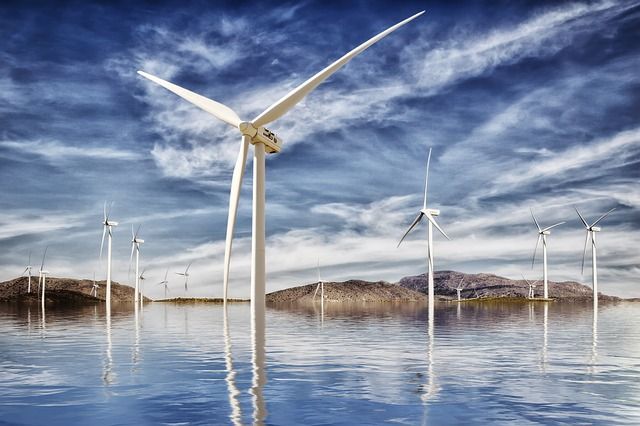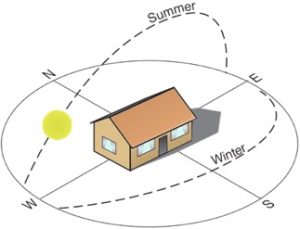By: Nicole Schlabach
Man-made structures should co-exist with their surroundings. Ecosystems thrive because of the interconnected nature of natural systems.
Similarly, architects can harvest rich, free benefits from their surroundings by building in harmony with their environment.
Too often, buildings are constructed by altering the landscape to fit pre-existing needs.
Instead, you should approach your landscape with an open mindset to see how you can leverage sun, rain, and temperature patterns.
If you’re looking to build a commercial building, make sure you don’t miss out on these opportunities.
1. Get Strategic About the Sun’s Rays
While considering the amenities of your new office location, consider the sun as well. It’s a little-known fact that strategic building orientation correlates with energy efficiency.
The ideal structure receives more sunlight (warmth) in the winter and less in the summer. This way, you’ll pay less to heat and cool your building.
According to the US Department of Energy, a passive solar home may cost half as much to heat as a typical one. Cost savings benefits apply to commercial buildings, too.
For background, the sun is positioned in the southern sky in the winter and in the northern sky in the summer.
You’ll want to orient your building so the longest sides face the north and south axis and the shortest sides face the east and west axis.
Source: Nachi.org
After deciding your building’s orientation, choose where to put your windows. Place more windows on the southern side of your structure than the northern side.
The combination of orientation and windows allows your building to exist in harmony with yearly solar patterns. It will receive less solar energy during the summer and more during the winter.
When designing your building, make sure you ask for a solar study. This assessment will reveal exactly how the sun impacts your building throughout the year.
The sun offers free solar warmth — make sure you capitalize on it! Your utility bill and employees will thank you for creating a more comfortable, efficient workplace.
2. Go Beyond Drainage, Rainwater is a Resource
When designing a building, water drainage is an essential concern. However, instead of getting rid of water, have you considered reusing it?
Water, just like the sun, can be a free resource if you’re creative enough to leverage it. Amazingly, up to half of the non-potable water your commercial building uses each day could be swapped with rainwater.
The Edge, named the smartest building in the world by Bloomberg, is a phenomenal example of how to reap pre-existing services offered by a landscape.
It reuses its rainwater for purposes that normally require an external water source.
Water that falls on the roof and balconies is collected into a concrete container behind the parking garage. Then, the stormwater is used to flush toilets and irrigate green terraces and gardens.
Underground, another tank serves as an aquifer thermal energy storage system for The Edge. This means it uses water for the building’s heating and cooling.
The Edge uses innovative techniques. But, everyday office spaces can employ rainwater harvesting, too. Bins can be installed above or below the ground, and they’re typically fed by gutters surrounding the building.

Source: Renewableenergyhub.co.us, Courtesy of Stormsaver Ltd.
According to Rainwater Resources, any commercial building with a large roof and demand for non-drinkable water is a candidate.
Consult the Renewable Energy Hub for the United States to learn more, find a local installer, and compare prices.
3. Greenspace Isn’t Just For Humans — Consider Plants & Animals, Too
Employees who have access to greenspace are more productive. Your greenspace could benefit your local ecosystem too.
If you’re in the market for plants and outdoor structures, you might as well choose ones that will help the local environment thrive.
If you’re in an urban environment, greenspace can provide a valuable refuge for insects and animals.
For example, The Edge put an ecological corridor on its terrace. It holds vegetation that’s friendly to important pollinators. Hive towers featuring tiny holes support local bee populations.
The Edge’s greenspace also features birdhouses and bat boxes in its landscaping for the creatures to nest.
If you’re buying plants, anyway, you should choose native vegetation. Choosing plants that occur naturally in your area will provide benefits to local organisms and require less caretaking.
Be smart about your outdoor space, and you’ll foster mutually beneficial results for the environment and your employees.
Take a Holistic Approach to Your Building’s Design
Since you’re already designing a new building, you might as well take advantage of the existing benefits nature provides.
Orient the building so it benefits from yearly sunlight patterns, and consider harvesting rainwater instead of simply draining it.
Choose to create a building that sustains, rather than degrades, the environment by supporting local organisms in your outdoor space.
Since your building doesn’t exist in a vacuum, your design strategy shouldn’t, either.
 Nicole Schlabach leads real estate and architectural design research efforts for Clutch, a ratings and reviews platform for B2B services and solutions providers.
Nicole Schlabach leads real estate and architectural design research efforts for Clutch, a ratings and reviews platform for B2B services and solutions providers.
To read more articles from Clutch, click here.
Thank you for reading. Please drop a line and help us do better.
Regards,
The CSR Journal Team


